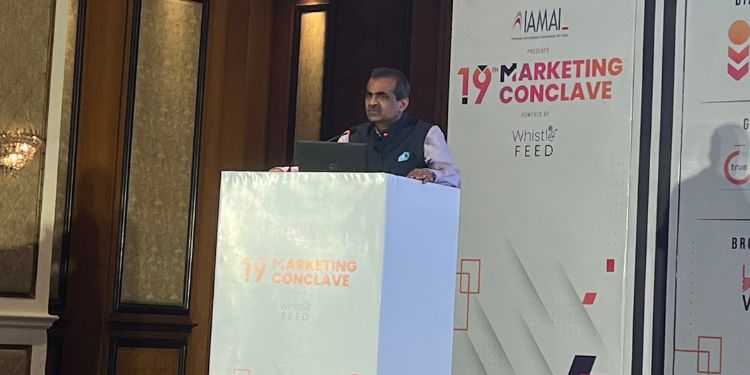Vikram Sahay, Joint Secretary, Ministry of Information and Broadcasting, Government of India, delivered the keynote at the 19th edition of the Marketing Conclave (MarCon) organised by the Internet and Mobile Association of India (IAMAI) in Mumbai on November 22, 2023.
The theme of the summit this year was, “Tomorrow’s Canvas: Tech and the Art of Marketing”.
Sahay acknowledged the role of the IAMAI in coming up with important ideas on adopting principles of self-regulation of content on multiple platforms. The system of self-regulation is working well in media and entertainment, he noted.
“We have what we call a co-regulatory environment and that has been working quite well for a period of time. If at all, there has to be some discussion of what can be a possible regulatory environment for digital advertising,” noted the speaker.
SMEs are now playing a very very important role in digital advertising, reflecting the deepening and widening of the Indian market, he noted.
“Today, internet usage is more in rural areas than it ever was. The middle class has grown so much, the rural area has prospered so much and internet usage is more prevalent. It’s quite surprising but the greater usage is in tier 2 and tier 3 cities than tier 1 cities,” said Sahay.
He attributed this to the proliferation of smartphones and the low data cost.
“You have around 50 to 60 crore people who are using smartphones in the country. The shift of consumer behaviour from traditional platforms to smartphones is a major reason why we see the growth of digital advertisers. An average Indian is spending 7 hours every day on their mobile. Whether they’re watching news, they’re watching entertainment, they’re watching OTT, they’re watching advertising, they are buying products,” he observed.
Digital advertising is thriving because of its inherent advantage of the ability to target the audience based on age, gender and location, among other parameters, and from searching for products on a search engine, users are now directly moving to e-commerce platforms, he noted.
Hence, advertising on an ecommerce platform has become ‘very, very important’ opined the speaker.
Role of AI
Even the best of the tech like ChatGPT and Midjourney cannot offer that uniqueness that creative advertising made by humans can, noted the speaker, citing ads like Hamara Bajaj, Cadbury and Ericsson (One Black Coffee Please).
“These are things that get embedded in you. This is the way advertising should be. It’s really the innovation of advertisers and some of the great minds (sic). So I just hope that we do not use ChatGPT or any such services and downgrade our quality of the services in advertising because advertisement is all about making a product or a service unique in the mind of the customer. The best of the software will never give you the uniqueness the human brain can,” he added.
While technology may lower cost and increase efficiency, he said, “But as a consumer I would not like the quality of advertisement to be compromised because of the software. I speak as an average citizen in this country. Understanding and capturing human behaviour is also very important.”
Big data and analytics has helped capture human behaviour much better than before, he added.
Causes for Concern
The speaker pointed to instances of cyber fraud ranging from advertising to financial fraud.
“The other big issue which we have been trying to grapple with has been the online betting platforms,” noted Sahay.
There are a large number of online betting platforms, mainly of foreign origin, noted the speaker, pointing to issues ranging from financial frauds to financial embezzlements to tax evasion, terming it a ‘huge social issue’. Now there are regulatory practices in place, he added.
The I&B Joint Secretary touched upon misleading ads in education, including those from coaching institutes that claimed top ranking students as theirs, and unethical advertising in health products.
“Now, this type of misleading advertisements are something which we need to take care of, and that is unethical practice. An unethical practice has no space in an ethical world. We need to stop that,” said the speaker.
He cited issues on the share of digital revenue going to news publishers, leading to Australia coming up with legislation to balance the revenue between the tech companies and publishers..
Referring to influencers, the official pointed to the role and responsibilities of intermediary platforms. While what the influencer is promoting is also an advertisement, the platforms through which they talk to audiences claim it’s not an advertisement from their end because they are not pushing the product, opined the speaker.
“When we look into developing a regulatory environment, what is objectionable offline is also objectionable online. It is as simple as that. We look at whether an ad is objectionable from several perspectives,” observed Sahay.
He added, “The principles of what can be the codes, what can be the do’s and don’ts, do not change, only the platform changes. That is the first very important guarding principle which we are going to follow.”
On self-regulation, the speaker underlined that the principle of self regulation was permanent. “It is not for the government to look into the ads. We are not here to monitor. It is humanly impossible. There is no intention to sit and monitor every ad that is coming in a digital space. We need to talk about how we can develop, adopt and mature a system of self regulation, together.”
The speaker surmised underlining the need to balance the interests of advertisers and content creators on one side, and the best interests of consumers and enabling them to make informed decisions on the other.
Feedback: [email protected]

















